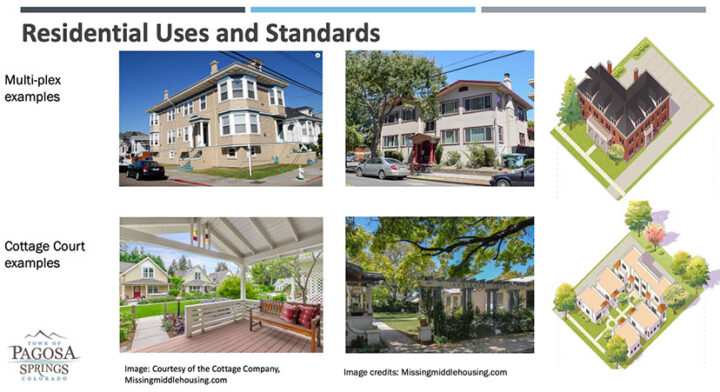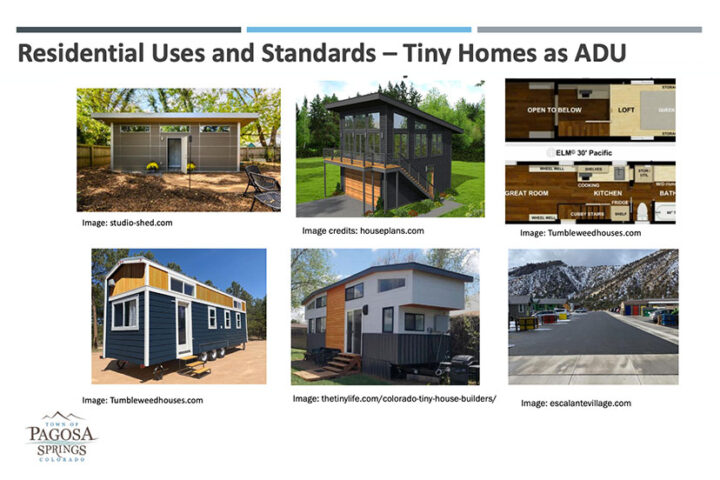The presentation to the joint meeting, by Town of Pagosa Springs Senior Planner Karl Onsager, touched on a number of topics that might — or might not — be addressed more comprehensively in the Town’s proposed Land Use and Development Code (LUDC) update.
We discussed, yesterday, the possibility that the Town might ‘upzone’ certain existing neighborhoods, to allow apartments, cottage courts, and other types of denser residential development, to address (presumably) the dire shortage of workforce housing in our community. The Town Planning Commission and Town Council was asked to comment on the proposed ideas.
The text from the 29-page PDF:
Intent of the Section
- To provide a variety of housing types that align with appropriate zone districts, transportation networks, community needs, and individual preferences
Proposed amendments
- Add new ‘missing-middle’ housing types: Cottage Courts, Multi-Plex
- Potential Tiny Homes on Wheels as ADUs
- Clarify types and applicable subdivision process
- Clarify definitions: Single-household detached and attached, multi-household, townhomes, duplexes
Potential options:
- Keep current types with some clarification
- Increase in available housing types
Requested direction:
- Confirmation of proposed housing typology.
We might note the phrase “individual preferences”. This could refer to the “individual preferences” of the builder, or to the “individual preferences” of the people living in the housing. Concerning the “individual preferences” of the people living in the housing, we might assume that people would prefer to pay less than $2,500 a month for rent, considering that some jobs in Pagosa pay about $2,500 a month.
The existing LUDC is not as flexible about allowing “individual preferences” as might be assumed in a supposedly democratic society. So perhaps an update is appropriate?
Some other housing options that the joint meeting was able to discuss looked like this:
As far as I know, these types of dwellings — which are popular in many places in America, and might well be popular in Pagosa Springs someday — are not currently allowed under the existing LUDC.
Council member Brooks Lindner:
“I’m certainly not opposed to allowing these types of products.”
Council member Mat deGraaf:
“Yes, I’m completely in favor of definitions of what is allowable, to accommodate what people bring forward. To an extent, of course. When I think about the tiny homes on wheels, that’s a funny pot. But it’s a price point for many people. To say ‘No’ is not fair, especially when you’re talking about someone putting it on their own property. So yeah, I’m in favor of all these options.”
Community Development Director James Dickhoff noted that the state of Colorado is working on official requirements — plumbing, electrical, etc. — for tiny homes, so that building and planning departments can feel comfortable that these small, portable homes are ‘safe’.
Once upon a time, it was the homeowner’s responsibility to ensure that their home was ‘safe’. The house I live in, in downtown Pagosa Springs — for example — was built in the year 1900, before there was such a thing as a building and planning department in Pagosa. Somehow, the house has lasted for 123 years, probably because most ordinary human beings — left to their own devices — build homes that they hope will last for a century or more, wherever in the world they live.
But home building has become so complicated, thanks to government regulations, that ordinary Americans rarely feel qualified to build a house that will last for a century or more.
Council member Gary Williams:
“I just want to say, I’m with my colleagues. I’m in favor of widening the range of housing.”
Senior Planner Onsager clarified that the LUDC, as currently proposed, would not allow tiny homes as a ‘primary home’. They would be allowed only as secondary units. ‘ADUs”. “Accessory Dwelling Units”.
Community Development Director James Dickhoff then noted that the Colorado General Assembly is currently considering a bill numbered SB23-213, which might prohibit a municipal government from setting size limits on single-family housing units, and also might require municipal government to allow tiny homes and manufactured homes in all residential district. That bill has passed the Colorado Senate and was approved this week by the House Transportation, Housing & Local Government Committee. The General Assembly will adjourn on May 8, so it’s not clear if the bill will make it through the House.
When I looked at the voting for SB23-213, every “Yes” vote has been a Democrat, and every “No” vote has been a Republican. In other words, this does not appear to be a bipartisan bill.
Colorado has generally assigned land use decisions to local government, so this bill, SB23-213, is a bit unusual in that regard.
A comment by Planning Commissioner Peter Adams:
“Personally, I’m all for increasing the density in town. This will add to that intention.”
Planning Commissioner Kristen McCollam:
“I agree. And I guess, to your comment, James… the tiny home development proposed for the parcel next to Walmart… falls under the provision that’s already passed? Is that what I understood from your comments?”
Mr. Dickhoff explained that the existing LUDC would allow a tiny home village only through the Planned Unit Development (PUD) process.
Which is to say, the Town Council and Planning Commission and Community Development Department have ways to approve developments that are not normally allowed, using the PUD process, if the development is promising some type of special social benefit.
In practice, almost anything can be defined, by the approving boards, as a ‘benefit’. It’s just a matter of being creative.
Council member Matt DeGuise spoke about creativity.
“I think everyone is in agreement, that the more we can be creative with our housing choices, the more flexibility and options we have… the better chance we have of building some affordable housing.”
We have one more type of development regulations to discuss. “Sustainability” regulations.



